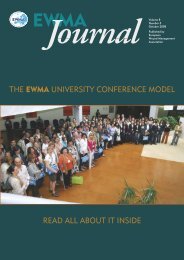best practice for the management of lymphoedema ... - EWMA
best practice for the management of lymphoedema ... - EWMA
best practice for the management of lymphoedema ... - EWMA
Create successful ePaper yourself
Turn your PDF publications into a flip-book with our unique Google optimized e-Paper software.
TABLE 7 Compression garment recommendations <strong>for</strong> specific problems in lower limb <strong>lymphoedema</strong><br />
Problem Recommendations/notes<br />
Swollen toes Where toe caps are difficult to manage, closed toe garments may be helpful<br />
COMPRESSION<br />
GARMENTS<br />
Forefoot swelling No risk <strong>of</strong> toe swelling – use open toe garments; flat knit is preferable<br />
Toe swelling – use open toe garment and toe caps, unless toe caps are impractical, when a<br />
closed toe garment may suffice<br />
Lymphoedema <strong>of</strong> <strong>the</strong> foot only – inelastic adjustable foot wrap may be useful<br />
Forefoot bulge Custom made flat knit garments may be required to produce sufficient pressure<br />
An individually shaped foam pad can apply additional pressure<br />
Inelastic adjustable footwrap may be useful<br />
Check that footwear is well-fitting and supportive<br />
Retromalleolar swelling Foam, crescent shaped stasis pads can be used to focus pressure<br />
Fat/arthritic knees Low classification pantyhose under a calf stocking may be useful <strong>for</strong> shape distortion <strong>of</strong> <strong>the</strong><br />
knee and thigh<br />
If using circular knit, use an extra wide calf range<br />
Thickened tissue just below patella Below knee garments can exacerbate <strong>the</strong> problem; ideally use full leg garments<br />
Pressure can be focused by using a crescent shaped ribbed or foam chip stasis pad over<br />
thickened area<br />
If a below knee compression garment is necessary, a stasis pad can be used with an<br />
orthopaedic elasticated knee support<br />
Inverted champagne bottle legs Limb shape should be corrected with MLLB<br />
Flat knit appears to be more effective than circular knit<br />
May need higher pressure levels<br />
May need custom made garments<br />
If using two garment layers, use a combination <strong>of</strong> flat knit and circular knit<br />
Lymphoedema extends to groin Flat knit custom made garments, eg one- or two-legged closed gusset panty, should be used<br />
A foam chip pad angled into <strong>the</strong> groin under <strong>the</strong> compression garment may be used to focus pressure<br />
Close fitting shorts with Lycra (eg cycle shorts) are convenient <strong>for</strong> some patients<br />
Obesity May need custom made garments; flat knit may be easier to apply<br />
Garments designed to accommodate pregnancy may be useful<br />
Severe distortion <strong>of</strong> <strong>the</strong> lower limb or patient preference may restrict treatment to <strong>the</strong> lower<br />
part <strong>of</strong> <strong>the</strong> leg<br />
Using separate overlapping garments <strong>for</strong> above and below <strong>the</strong> knee may make application easier<br />
SAFETY ISSUES<br />
Lower limb peripheral arterial occlusive disease<br />
The lower limb peripheral arterial status <strong>of</strong> patients with lower limb <strong>lymphoedema</strong> should<br />
be assessed prior to compression. Patients with ABPI

















